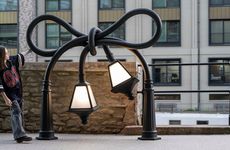The best public art mimics nature, as Pierre Vivant's Traffic Light Tree does. This giant sculpture of fully-functioning traffic lights is in London adjacent to a roundabout near Canary Wharf.
Pierre Vivant's Traffic Light Tree was created by the Public Art Commissions Agency. I imagine this would confuse tourists considerably; traffic circles are confusing enough, even for veteran drivers. The light cycles of the Traffic Light Tree are meant to mimic the constant action at Canary Wharf.
Implications - Inventor Pierre Vivant claims the sculpture follows the rhythmic patterns of surrounding activities, whether they are commercial, professional or domestic. The sculpture is intended to imitate the London Plane Trees which lie adjacently to it.
Infrastructure That Mimics Nature
The Traffic Tree
Trend Themes
1. Mimicking Nature in Public Art - Opportunity to create more public art installations that mimic natural elements and surroundings, enhancing the aesthetic appeal and connection to the environment.
2. Functional Sculptures - Potential for creating large-scale sculptures that not only serve as art pieces but also have functional purposes, like fully-functioning traffic lights in this case.
3. Interactive and Thought-provoking Art - Increasing demand for art installations that engage and intrigue viewers, sparking conversations and exploration of the surrounding environment.
Industry Implications
1. Public Art - Public art organizations and artists can explore innovative ways to incorporate functional elements into their installations, enhancing their impact and usefulness.
2. Urban Planning - Opportunity for urban planners to integrate functional sculptures into urban landscapes, improving the aesthetic appeal and functionality of public spaces.
3. Tourism and Hospitality - Hotels, resorts, and tourist destinations can invest in interactive art installations that attract visitors and provide unique experiences, contributing to the overall appeal and competitiveness of the destination.






